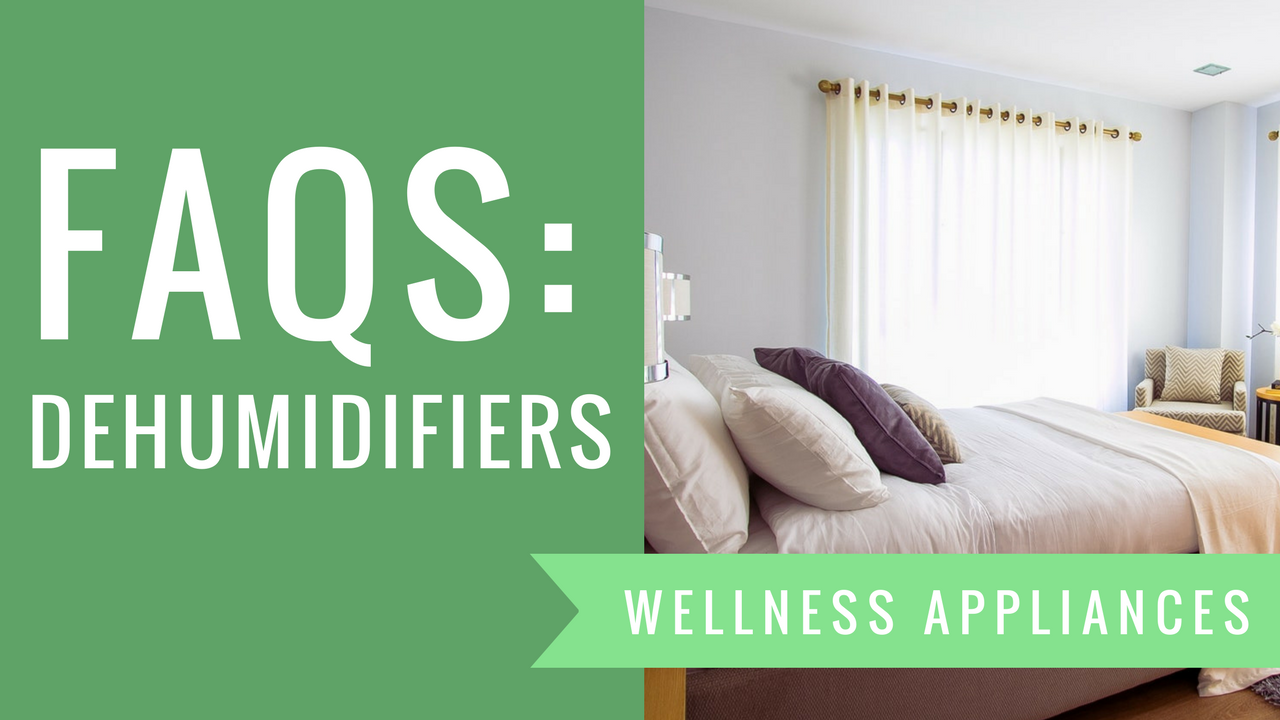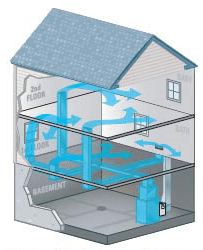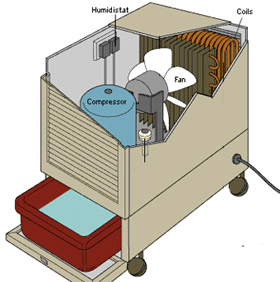Contents
- 1. What is a dehumidifier used for?
- 2. What is the cost to run a dehumidifier?
- 3. How long can I run a dehumidifier?
- 4. Can I leave a dehumidifier on 24-hours a day?
- 5. What should I set my humidity level at?
- 6. How much does it cost to run a dehumidifier 24 hours a day
- 7. How to use a dehumidifier properly
- 8. How to use a dehumidifier to eliminate mold
- 9. What if the dehumidifier is too small?
- 10. What if the dehumidifier is too large?
- 11. Dehumidifiers and high electricity usage
- 12. Can the water bucket overflow?
- 13. Can I lower the humidity to zero or 5 to 10%?
- 14. Is there a humidifier that will lower humidity to 5 or 10%?
- 15. Can the water be used that’s in the water tank?
- 16. Is there something better than a dehumidifier?
- 17. What is a good humidity level for a basement?
- 18. Where to place a dehumidifier in the basement
- 19. When to use a dehumidifier in the basement
- 20. Dehumidifier placement—upstairs or downstairs?
1. What is a dehumidifier used for?
A dehumidifier is used to remove water vapor in the air in homes and commercial/industrial buildings. They are used in specific rooms, basements, crawl spaces, attics, RVs, boats, and anywhere you have too much humidity.
2. What is the cost to run a dehumidifier?
A 65-pint dehumidifier will draw roughly 600 Watts. 0.6 kW x 3 hours = 1.8 kWh. 1.8 kWh x 20c/kWh = 36 cents for a 3-hour cycle. If it’s on 50% of the time during a 24-hour period that is about $1.50 a day. That 20-cent figure may not include tax and other utility charges so the actual cost may end up being higher. Volts x Amps = Watts.
Call your power company because all states and cities charge different rates. They will be happy to tell you.
3. How long can I run a dehumidifier?
Dehumidifiers do not have exact rules for how long to run them. Check the model you want to purchase and the specifications will tell you. They are rated by pints per day. You need to determine the amount of humidity to remove and set that, run the unit on automatic, and it will shut off automatically when the water tank is full. You can run the units 24/7 and all year. Read the instructions that came with your dehumidifier if you have purchased one. All dehumidifiers are different in operation, yet similar.
4. Can I leave a dehumidifier on 24-hours a day?
Yes, if your unit provides that function. Read the instructions that came with your dehumidifier if you have purchased one or read the specifications for the ones you are interested in purchasing.
5. What should I set my humidity level at?
Humidity above 75% helps mold to grow along with mildew, bacteria, and dust mites. The best humidity level indoors is 40% to 60%. Buy a hygrometer to measure the humidity and check it for a few days to set the dehumidifier’s level to the ideal level.
6. How much does it cost to run a dehumidifier 24 hours a day
That depends on how long you run it. You could buy one of these and the device will compute it for you. Alternatively, you can do this: A 65-pint dehumidifier will draw roughly 600 Watts. 0.6 kW x 3 hours = 1.8 kWh. 1.8 kWh x 20c/kWh = 36 cents for a 3-hour cycle. If it’s on 50% of the time during a 24-hour period that is about $1.50 a day. That 20-cent figure may not include tax and other utility charges so the actual cost may end up being higher. Volts x Amps = Watts.
7. How to use a dehumidifier properly
Most of the dehumidifiers have top-mounted air discharge venting and that means you can place those against walls. If your unit is not top-mounted, be sure the unit is 12-inches away from furniture, walls, and doors so that the air can freely circulate around the dehumidifier for better operation. Be sure all doors and windows are closed when it is running to be efficient and do the job it was designed to do. Do not place near dirt and dust or equipment used for carpentry because the sawdust will clog the grills and coils and the unit will not work.
Be sure the unit is plugged into a USA 110/120-Volt grounded outlet. Do not use an adapter with 3 holes because it is not grounded. It simply allows you to plug in the round prong on the plug end. You will defeat the safety purpose of the unit and could cause a fire. The unit can be hardwired into your electrical panel by a qualified electrician if you plan to keep it in one place.
Do not have the water drainage next to electricity. Unplug the unit before removing the water. If using a hose to a drain, be sure it is not close to the cord or other electricity.
Do not construct a tripping danger by using a hose or tube that is too long from the unit to the drain. Be sure the dehumidifier is close to the drain or sump to dispose the water.
Warm air is created from the unit as the moisture is removed by the dehumidifier. Do not be distressed about this; it is normal.
8. How to use a dehumidifier to eliminate mold
 Mold is a critical and very serious problem. The musty smell is difficult to remove. Mold is a fungus, not bacteria as some websites state.
Mold is a critical and very serious problem. The musty smell is difficult to remove. Mold is a fungus, not bacteria as some websites state.
Molds are good for destroying tree stumps, apples, and peaches on the ground in your backyard. Good fungus is mushrooms. Specific molds cause extreme property damage.
Mold destroys and eats drywall (sheetrock) and ceiling tiles for example. Mold grows on roofs and the attic could be affected. See mold growth on an orange.
 Small black spots are black mold spores caused by moisture. Dehumidifiers will prevent mold from growing. You will need some vinegar and water to remove the existing mold. It will come back without a dehumidifier. Never paint over it; clean it first.
Small black spots are black mold spores caused by moisture. Dehumidifiers will prevent mold from growing. You will need some vinegar and water to remove the existing mold. It will come back without a dehumidifier. Never paint over it; clean it first.
Mildew is a type of fungus. It is not the same as mold. It is usually gray/black. The spores permeate the air and land on damp wet places such as concrete, wood, carpet, clothes, walls, and smell up the place with the musty odor.
People are sensitive to the smell, it can be allergic, and asthmatics have a hard time with it. You do not want to breathe in mold spores. People with respiratory illnesses should stay away from moldy areas.
A dehumidifier will dry your environment so that mold, mildew, bacteria, and other pollutants do not grow. Follow the manufacturer’s instructions and set the level at 35% to 50%. Mold grows at 60% and above. However, how can this be substantiated in your home or building?
9. What if the dehumidifier is too small?
The dehumidifier will operate continuously and it will be unable to reduce the humidity to the desired level if it’s too small in capacity. If the unit cannot reach and maintain humidity levels below 55% mold might grow.
10. What if the dehumidifier is too large?
The dehumidifier will not run as long or as often for the humidity level you want and set it for. A larger unit uses much more electricity than a smaller one. A large unit running less time can use as much electricity as a small one even though it runs less. When the compressor starts, electricity is consumed.
11. Dehumidifiers and high electricity usage
The compressor uses power to circulate and compress the refrigerant. It uses more electricity than the amount used for the fan to run.
12. Can the water bucket overflow?
The water reservoir, or bucket, will not overflow because the dehumidifier uses a float switch to shut the unit off when the water is at the top level. Most units shut down automatically when this level is reached.
13. Can I lower the humidity to zero or 5 to 10%?
No. It’s because of the dew point. The refrigerant system cools the air entering the dehumidifier leaving the moisture on the evaporator coils. When you see dew on the lawn and flowers in the morning, the air temperature has dropped low to reach the dew point and that is created from temperature and humidity. As the temperature and humidity go down, so does humidity. If your humidifier can only cool the air going into it at 35 to 45 degrees F., with the dew point lower than this, no more moisture can be removed from the internal air. If your room temperature is 50 degrees F. and the humidity is 50 percent, the dew point will be 32 degrees F. so there is no moisture removed until the dew point reaches 35 to 45 degrees F. When the air is saturated with moisture, it cannot hold anymore.
14. Is there a humidifier that will lower humidity to 5 or 10%?
The desiccant humidifiers do not use refrigeration, compressors, or coils to remove moisture from the air. These units dehumidify through an adsorption (not absorption) process. Adsorption is a surface occurrence where particles or molecules bind to the top layer of a material such as a silica gel, charcoal, and other materials. Air is taken into the unit passing over a wheel rotating that is saturated with silica gel. The air going over the wheel with its humidity is absorbed by the silica gel before passing out of the dehumidifier as warm air. The use of desiccant dehumidifiers is good for low-temperature humidifying. See this dehumidifier. The water goes into the reservoir or tank that holds the water.
15. Can the water be used that’s in the water tank?
The water is condensation. Use it in your steam iron, water the plants, or dump it out. You should not drink it nor your pets. It could make you sick. It is not fresh water.
16. Is there something better than a dehumidifier?
Move to a dry climate will work! Expensive ventilation systems will work in place of a dehumidifier. To remove excess moisture, a dehumidifier is the way to go.
17. What is a good humidity level for a basement?
Basements are below grade so the air is cooler. Cooler air holds more humidity. High humidity causes mold to grow in the basement. Mold and mildew give off the musty odor. Whether your basement is finished or not, mold thrive in relative humidity above 80%. The humidity on your dehumidifier should be set at 50%. Use a thermo-hygrometer to give you levels of humidity. Measure the humidity of the room area separate of the dehumidifier for your information.
18. Where to place a dehumidifier in the basement
Basements are cold places and that leads to water condensation due to cold air having more humidity. A humidifier for the basement will keep the space dry. For the best performance, it’s important to put the humidifier in the best place. Be sure all windows and doors are closed because humidifiers work best in enclosed areas. Since the air needs to flow freely through the coils, place the dehumidifier 12-inches from walls and furniture. If your dehumidifier has a top-mounted air discharge where the warm air escapes, you can put the unit against the wall. Read the specifications of the model you want to purchase, and if you already own one, read the manufacturer’s instructions carefully. If you do not have sufficient air circulation, a single humidifier will not dry out storage areas adjoining your basement. If you have storage rooms, closets, or laundry rooms in the basement, you will need additional humidifiers to do the task of drying the basement area.
19. When to use a dehumidifier in the basement
You will definitely need to use a dehumidifier in the basement area when the air feels clammy and sticky; mold is growing on the walls and elsewhere; it smells musty from mold and mildew; the walls feel damp when you touch them; moisture is coming up from the concrete floor; items stored smell musty; and if carpeted, there could be mold and mildew coming up from the subfloor.
A dehumidifier will be great for these problems turning a nasty space into a livable environment. Be sure the temperature range is adequate for your basement area with automatic shut off and automatic draining.
20. Dehumidifier placement—upstairs or downstairs?
Place portable units where you need them. If downstairs, the dry air will not drift much to the upstairs. You will need units on both floors. A whole-house dehumidifier will eliminate this problem because the air travels through the ductwork of the furnace to all floors. Calculate the square footage for the area you want to dehumidify for a portable unit.




